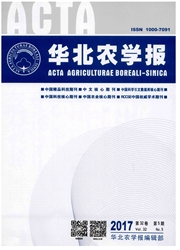

 中文摘要:
中文摘要:
利用简单钙溶液培养法对广东高州普通野生稻部分编号进行了耐铝性鉴定,对盆栽条件下低pH值和Al胁迫对植株重要农艺性状的影响进行了调查,并利用铝敏感品种华粳籼74为受体与高州普通野生稻耐铝性编号为供体所构建的高世代回交群体BC3F3对高州普通野生稻耐铝性QTL进行了初步定位分析。结果表明,在铝处理浓度为50μmol/L的0.5 mmol/L CaCl2(pH值=4.5)溶液培养24 h后,供试的8个野生稻材料种子根的相对根伸长量RRE均大于0.5;以其中4个编号的离蘖茎新生根在相同胁迫条件下培养,发现其仍然表现RRE〉0.5。表明供试野生稻具有耐铝性。盆栽试验结果表明,Al胁迫对野生稻和栽培稻植株株高影响明显,处理材料的株高明显低于对照,结实率和千粒质量也受到Al胁迫的不利影响。利用以华粳籼74为受体与供试野生稻构建的BC3F3群体,运用基于混合线性模型的复合区间作图法(MCIM)进行QTL分析,共鉴定到4个耐铝毒QTL。其中qRRE-6-2与qRRE-7-2来自华粳籼74×GZW003的BC3F3群体,qRRE-4与qRRE-2-2则分别来自华粳籼74×GZW006及华粳籼74×GZW087的BC3F3群体。这4个QTL分别解释了表型遗传变异的18.33%,9.18%,19.02%,24.88%;除qRRE-6-2外,其余3个耐铝性增效基因来均自供体亲本高州普通野生稻。
 英文摘要:
英文摘要:
In this study,the tolerance to aluminum of eight accessions of O.rufipogon indigenous to Gaozhou was identified by culturing in simple CaCl2 solution,and some important agronomic traits of rice plants cultured in pot soils with low pH or adding Al were investigated,Al-tolerance related QTLs were also mapped primarily by using the advanced backcross population BC3F3 between Huajingxian 74 and accessions of O.rufipogon indigenous to Gaozhou.The results were as follow.After seedling roots of O.rufipogon were treated in 0.5 mmol/L CaCl2 solution with 50 μmol/L Al3+(pH=4.5) for 24 h,the relative root elongation(RRE) of eight accessions were all higher than 0.5.Meanwhile,RRE of the regenerative roots from tillerings of the four out of the eight accessions also higher than 0.5.It is considered that the experimental accessions of O.rufipogon were Al tolerant.Investigation of plant traits in the pot soil cultured experiments showed that the rice plant height was obviously affected by Al stress,also as seed setting rate and 1000-grain weight.Four QTLs related to Al-tolerance were mapped in BC3F3 population by the method of MCIM.Hereinto,qRRE-6-2 and qRRE-7-2,which were mapped in BC3F3 population derived from Huajingxian 74×GZW003,qRRE-4 and qRRE-2-2,which were mapped in BC3F3 population derived from Huajingxian 74×GZW006 and Huajingxian 74×GZW087,respectively.These four QTLs explained 18.33%,9.18%,19.02% and 24.88% of the phenotypic variance,respectively.Except of qRRE-6-2,the favorable alleles of the other three QTLs were all derived from the donor parent,O.rufipogon.
 同期刊论文项目
同期刊论文项目
 同项目期刊论文
同项目期刊论文
 期刊信息
期刊信息
